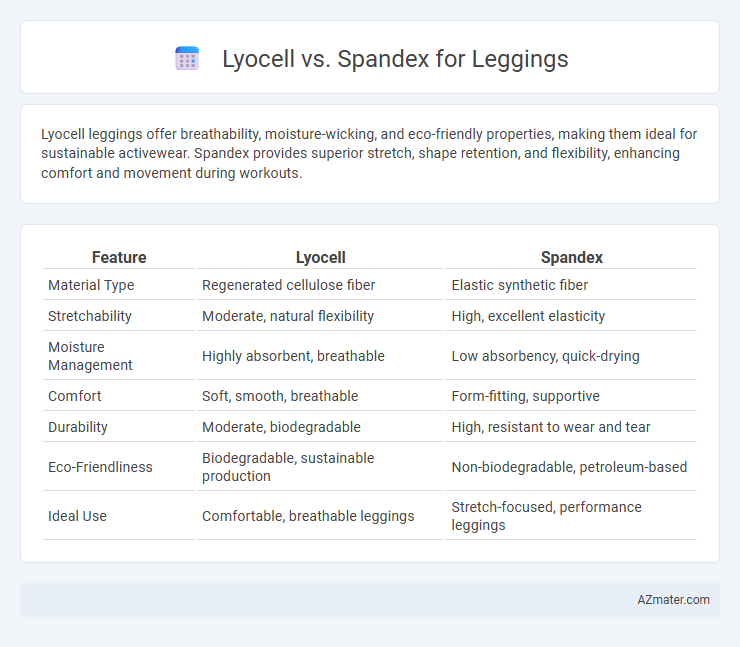Lyocell leggings offer breathability, moisture-wicking, and eco-friendly properties, making them ideal for sustainable activewear. Spandex provides superior stretch, shape retention, and flexibility, enhancing comfort and movement during workouts.
Table of Comparison
| Feature | Lyocell | Spandex |
|---|---|---|
| Material Type | Regenerated cellulose fiber | Elastic synthetic fiber |
| Stretchability | Moderate, natural flexibility | High, excellent elasticity |
| Moisture Management | Highly absorbent, breathable | Low absorbency, quick-drying |
| Comfort | Soft, smooth, breathable | Form-fitting, supportive |
| Durability | Moderate, biodegradable | High, resistant to wear and tear |
| Eco-Friendliness | Biodegradable, sustainable production | Non-biodegradable, petroleum-based |
| Ideal Use | Comfortable, breathable leggings | Stretch-focused, performance leggings |
Introduction to Lyocell and Spandex
Lyocell is a sustainable, biodegradable fiber derived from wood pulp, known for its breathability, moisture-wicking properties, and soft, smooth texture, making it ideal for leggings that prioritize comfort and environmental impact. Spandex, also known as elastane, is a synthetic fiber prized for its exceptional elasticity, durability, and ability to retain shape, ensuring leggings offer superior stretch and support during physical activities. Combining Lyocell with Spandex creates leggings that balance eco-friendly softness with flexible performance, catering to activewear needs with enhanced comfort and fit.
Material Composition and Origins
Lyocell leggings are crafted from regenerated cellulose fibers derived from sustainably harvested eucalyptus trees, offering moisture-wicking and breathable properties. Spandex, a synthetic fiber made from polyurethane, provides exceptional elasticity and shape retention, often blended with natural fibers for enhanced stretch. Combining Lyocell with Spandex in leggings results in a fabric that balances eco-friendly origins with superior flexibility and comfort.
Comfort and Breathability Comparison
Lyocell fabric in leggings offers superior moisture-wicking and breathability due to its natural cellulose fibers, making it ideal for all-day comfort and temperature regulation. Spandex enhances stretch and shape retention but lacks the breathability and softness of Lyocell, often causing increased heat buildup during prolonged wear. Combining Lyocell's moisture management with spandex's elasticity creates leggings that balance comfort and performance effectively.
Moisture-Wicking and Quick-Dry Properties
Lyocell leggings offer superior moisture-wicking capabilities due to their natural cellulose fibers, effectively drawing sweat away from the skin and enhancing breathability. Spandex, primarily valued for its stretch and flexibility, lacks inherent moisture-wicking properties but can be blended with moisture-managing fibers to improve performance. In terms of quick-dry features, Lyocell absorbs moisture efficiently and dries faster than traditional cotton, while spandex's synthetic composition supports rapid drying when combined with technical fabrics.
Stretchability and Shape Retention
Lyocell leggings offer excellent moisture-wicking and breathability but have moderate stretchability and shape retention compared to spandex blends. Spandex provides superior elasticity and exceptional shape retention, allowing leggings to maintain their fit through extensive wear and movement. Combining Lyocell with spandex blends enhances comfort, stretch, and durable fit, making leggings versatile for active and casual use.
Durability and Longevity
Lyocell leggings offer exceptional durability due to their strong, fiber structure that resists pilling and maintains shape over time. Spandex enhances stretch and recovery but can degrade faster with repeated wear and washing, potentially reducing overall longevity. Combining Lyocell with a small percentage of Spandex creates leggings that balance durability with flexibility for long-lasting comfort.
Eco-Friendliness and Sustainability
Lyocell leggings offer superior eco-friendliness due to their biodegradable fibers derived from sustainably sourced wood pulp, produced via a closed-loop process that minimizes chemical waste and water usage. In contrast, spandex, a synthetic fiber made from petrochemicals, lacks biodegradability and relies on non-renewable resources, raising concerns about long-term environmental impact and microplastic pollution. Choosing Lyocell over spandex supports sustainable fashion practices by reducing carbon footprint and promoting biodegradable, renewable materials in activewear.
Skin Sensitivity and Hypoallergenic Qualities
Lyocell leggings offer superior skin sensitivity benefits due to their natural, breathable fibers that reduce irritation and wick moisture effectively, making them ideal for sensitive skin. Spandex, while providing excellent stretch and shape retention, may cause discomfort for those with hypoallergenic concerns due to its synthetic composition and potential for trapping sweat. Opting for Lyocell blended leggings ensures a hypoallergenic, soft touch with enhanced moisture management, promoting overall skin health during wear.
Care, Maintenance, and Washability
Lyocell leggings require gentle care, recommending cold water wash and air drying to preserve their soft, breathable fibers and prevent shrinkage. Spandex leggings are highly durable and stretch-resistant, tolerating machine wash in cold water and tumble drying on low heat without losing elasticity. Proper maintenance of Lyocell involves avoiding harsh detergents and bleach, while Spandex benefits from avoiding fabric softeners to maintain its stretch and recovery features.
Best Use Cases for Leggings: Lyocell vs Spandex
Lyocell leggings excel in breathability, moisture-wicking, and sustainability, making them ideal for casual wear and light activities such as yoga or walking. Spandex leggings offer superior stretch, compression, and shape retention, perfect for high-intensity workouts, running, or any activity requiring maximum flexibility and support. Choosing between Lyocell and Spandex depends on whether comfort and eco-friendliness or elasticity and performance are the primary needs.

Infographic: Lyocell vs Spandex for Legging
 azmater.com
azmater.com